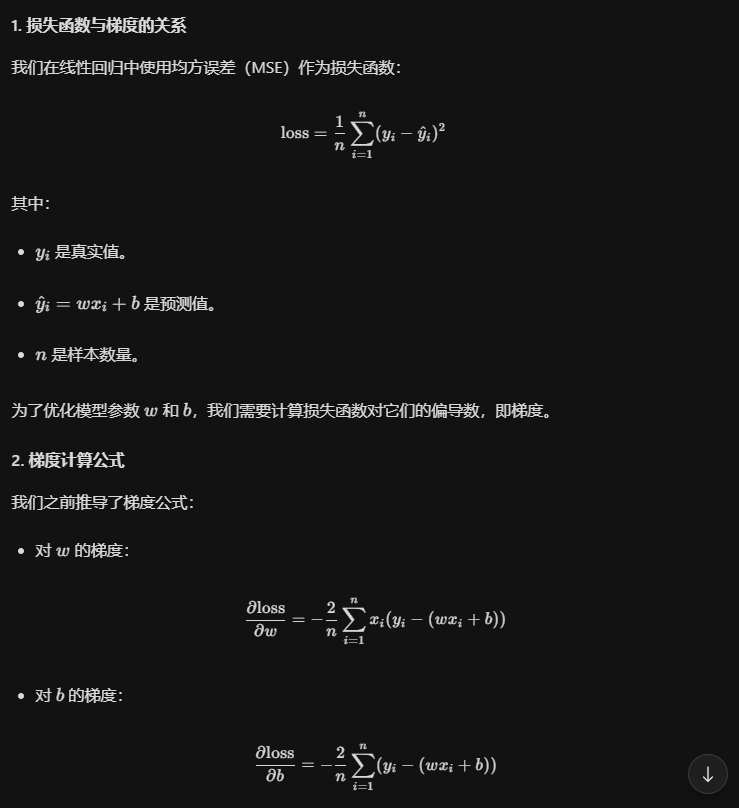线性回归 C++ 实现
参考链接
https://www.cnblogs.com/eat-too-much/p/16796533.html
代码
#include <iostream>
#include <vector>
#include <random>
#include <cmath>
#include <algorithm>
using namespace std;
// 计算点积
float dot_product(const vector<float>& a, const vector<float>& b) {
float sum = 0.0;
for (size_t i = 0; i < a.size(); ++i) {
sum += a[i] * b[i];
}
return sum;
}
// 生成数据
void synthetic_data(const vector<float> & w, float b, int num_examples, vector<vector<float>> & X, vector<float> & y) {
random_device rd;
mt19937 gen(rd());
normal_distribution<float> normal(0, 1);
X.resize(num_examples, vector<float>(w.size()));
y.resize(num_examples);
for(int i=0; i<num_examples; ++i) {
for(int j=0; j<w.size(); j++) {
X[i][j] = normal(gen);
}
float err = normal(gen) * 0.01;
y[i] = (float)(dot_product(X[i], w) + b + err);
}
}
// 批量数据迭代器
void data_iter(int batch_size, const vector<vector<float>>& features, const vector<float>& labels,
vector<pair<vector<vector<float>>, vector<float>>>& batches) {
vector<int> indices(features.size());
iota(indices.begin(), indices.end(), 0);
random_shuffle(indices.begin(), indices.end());
batches.clear();
for (int i = 0; i < features.size(); i += batch_size) {
vector<vector<float>> X_batch;
vector<float> y_batch;
int batch_end = min(i + batch_size, static_cast<int>(features.size()));
X_batch.resize(batch_end - i);
y_batch.resize(batch_end - i);
for (int j = i; j < batch_end; ++j) {
X_batch[j - i] = features[indices[j]];
y_batch[j - i] = labels[indices[j]];
}
batches.push_back({X_batch, y_batch});
}
}
// 线性回归模型
vector<float> linreg(const vector<vector<float>>& X, const vector<float>& w, float b) {
vector<float> y_hat(X.size());
for (size_t i = 0; i < X.size(); ++i) {
y_hat[i] = dot_product(X[i], w) + b;
}
return y_hat;
}
// 均方损失
float squared_loss(const vector<float>& y_hat, const vector<float>& y) {
float loss = 0.0;
for (size_t i = 0; i < y.size(); ++i) {
loss += pow(y_hat[i] - y[i], 2) / 2;
}
return loss / y.size();
}
// 小批量随机梯度下降
void sgd(vector<float>& params, const vector<float>& grads, float lr, int batch_size) {
for (size_t i = 0; i < params.size(); ++i) {
params[i] -= lr * grads[i] / batch_size;
}
}
void sgd_bias(float& b, float grad_b, float lr, int batch_size) {
b -= lr * grad_b / batch_size;
}
int main() {
// 真实参数
vector<float> true_w = {2.0, -3.4};
float true_b = 4.2;
// 生成数据
int num_examples = 1000;
vector<vector<float>> features;
vector<float> labels;
synthetic_data(true_w, true_b, num_examples, features, labels);
// 初始化模型参数
vector<float> w = {0.0, 0.0};
float b = 0.0;
// 超参数
float lr = 0.0001;
int num_epochs = 1000;
int batch_size = 10;
// 训练过程
for (int epoch = 0; epoch < num_epochs; ++epoch) {
vector<pair<vector<vector<float>>, vector<float>>> batches;
data_iter(batch_size, features, labels, batches);
for (auto& batch : batches) {
vector<vector<float>> X_batch = batch.first;
vector<float> y_batch = batch.second;
// 前向传播
vector<float> y_hat = linreg(X_batch, w, b);
// 计算损失 没有必要 python 用于 自动微分计算才需要
//float l = squared_loss(y_hat, y_batch);
// 计算梯度
vector<float> grad_w(w.size(), 0.0);
float grad_b = 0.0;
// 计算梯度(
for (size_t i = 0; i < y_batch.size(); ++i) {
float err = y_hat[i] - y_batch[i];
for (size_t j = 0; j < w.size(); ++j) {
grad_w[j] += err * X_batch[i][j]; // 无除法,变为 sum
}
grad_b += err; // 无除法,变为 sum
}
// 更新参数
sgd(w, grad_w, lr, batch_size);
sgd_bias(b, grad_b, lr, batch_size);
}
// 打印损失
vector<float> all_y_hat = linreg(features, w, b);
float train_l = squared_loss(all_y_hat, labels);
cout << "epoch " << epoch + 1 << ", loss: " << train_l << endl;
}
// 输出估计误差
cout << "w真实值: " << endl;
for (size_t i = 0; i < w.size(); ++i) {
cout << true_w[i]<< " ";
}
cout << endl;
cout << "w的估计误差: ";
for (size_t i = 0; i < w.size(); ++i) {
cout << true_w[i] - w[i] << " ";
}
cout << endl;
cout << "w的估计: ";
for (size_t i = 0; i < w.size(); ++i) {
cout << w[i] << " ";
}
cout << endl;
cout << "b的真实: " << true_b << endl;
cout << "b的估计误差: " << true_b - b << endl;
cout << "b的估计: " << b << endl;
return 0;
}
代码与公式对应

纵观代码 发现2 丢失了 因为2 被整合到了 学习率中
---------------------------我的天空里没有太阳,总是黑夜,但并不暗,因为有东西代替了太阳。虽然没有太阳那么明亮,但对我来说已经足够。凭借着这份光,我便能把黑夜当成白天。我从来就没有太阳,所以不怕失去。
--------《白夜行》




 浙公网安备 33010602011771号
浙公网安备 33010602011771号